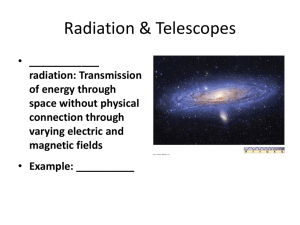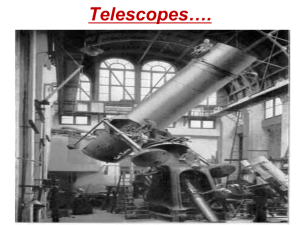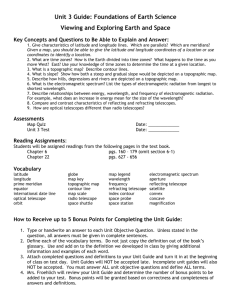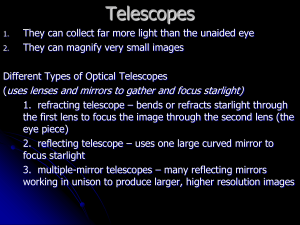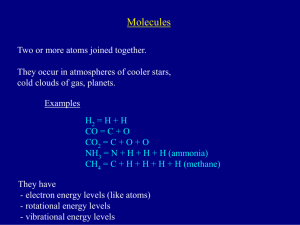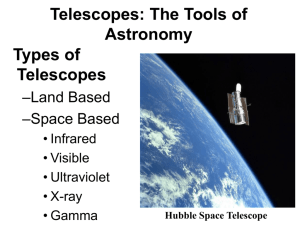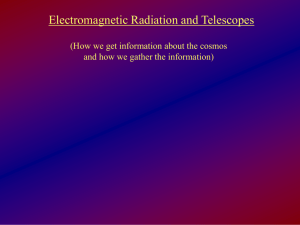Telescopes, Lens, and Light Notes
advertisement
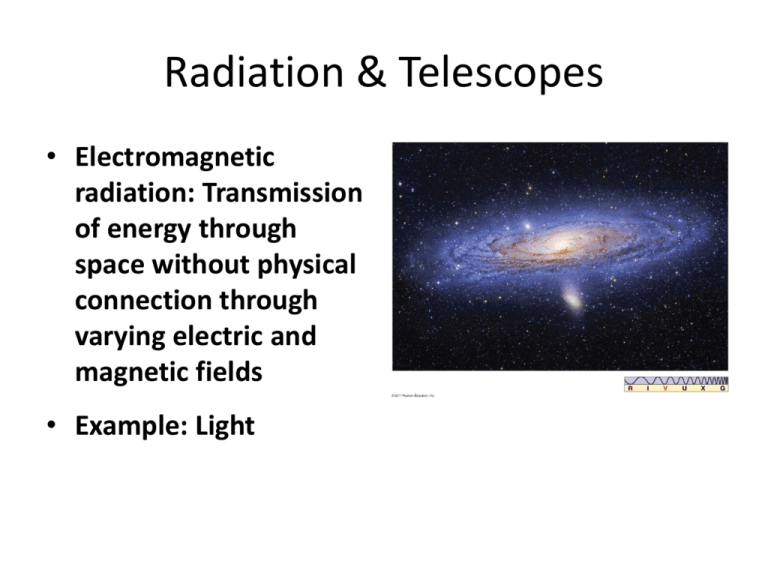
Radiation & Telescopes • Electromagnetic radiation: Transmission of energy through space without physical connection through varying electric and magnetic fields • Example: Light Wave Motion Label the Wave How we see light video Frequency: Number of wave crests that pass a given point per second Period: Time between passage of successive crests Relationship: Period = 1 / Frequency Wavelength: Distance between successive crests Velocity: Speed at which crests move Relationship: Velocity = Wavelength / Period No limit on wavelengths; different ranges have different names Note opacity of atmosphere Light and Color Bill Nye Video Waves The Speed of Light in Glass Video • Water waves, sound waves, and so on, travel in a medium (water, air, …) • Electromagnetic waves need no medium • Created by accelerating charged particles What is the wave speed of electromagnetic waves? c = 3.0 x 108 m/s This speed is very large, but still finite; it can take light millions or even billions of years to traverse astronomical distances Telescopes • Refracting lens Images can be formed through reflection or refraction Reflecting mirror Modern telescopes are all reflectors: • Light traveling through lens is refracted differently depending on wavelength • Some light traveling through lens is absorbed • Large lens can be very heavy, and can only be supported at edge • A lens needs two optically acceptable surfaces; mirror needs only one Types of reflecting telescopes The Keck telescope a modern research telescope The two 10-m telescopes of the Keck Observatory. (b) Artist’s illustration of the telescope, the path taken by an incoming beam of starlight, and some of the locations where instruments may be placed. (c) One of the 10-m mirrors. (The odd shape is explained in Section 5.3.) Note the technician in orange coveralls at center. (W. M. Keck Observatory) Sunrise on Mauna Kea in June The Hubble Space Telescope has a variety of detectors Hubble Telescope image before and after it was fixed Here we compare the best ground-based image of M100, on the left, with the Hubble images on the right Size • Light-gathering power: Improves detail • Brightness proportional to square of radius of mirror • Photo (b) was taken with a telescope twice the size of the telescope that took photo (a) Size • Resolving power: When better, can distinguish objects that are closer together • Resolution is proportional to wavelength and inversely proportional to telescope size— bigger is better! Figure 5-12. Detail becomes clearer in the Andromeda galaxy as the angular resolution is improved some 600 times, from (a) 10’, to (b) 1’, (c) 5”, and (d) 1”. (Adapted from AURA) Atmospheric blurring is due to air movements Solutions: • Put telescopes on mountaintops, especially in deserts • Put telescopes in space •Why is it Dark at Night video Radio telescopes • Similar to optical reflecting telescopes • Prime focus • Less sensitive to imperfections (due to longer wavelength); can be made very large •Largest radio telescope is the 300m dish at Arecibo Longer wavelength means poor angular resolution Advantages of radio astronomy: • Can observe 24 hours a day • Clouds, rain, and snow don’t interfere • Observations at an entirely different frequency; get totally different information Space Based Infrared radiation can produce an image where visible radiation is blocked; generally can use optical telescope mirrors and lenses Infrared telescopes can also be in space; the image on the top is from the Infrared Astronomy Satellite The Spitzer Space Telescope, an infrared telescope, is in orbit around the Sun. These are some of its images. Ultraviolet observing must be done in space, as the atmosphere absorbs almost all ultraviolet rays. X-ray image of supernova remnant Gamma rays cannot be focused at all; images are therefore coarse Full-Spectrum Coverage Figure 5-36. Multiple Wavelengths The Milky Way Galaxy as it appears at (a) radio, (b) infrared, (c) visible, (d) X-ray, and (e) gammaray wavelengths. Each frame is a panoramic view covering the entire sky. The center of our Galaxy, which lies in the direction of the constellation Sagittarius, is at the center of each map. (NRAO; NASA; Lund Observatory; MPI; NASA)


